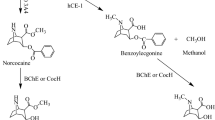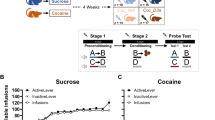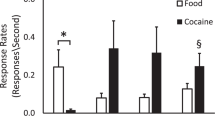Abstract
κ-Opioid agonists may functionally antagonize some behavioral effects of cocaine, but the role of mixed κ/μ receptor activity is unclear. The effects of three mixed κ/μ agonists (MCL-101, (−)cyclorphan, and Mr2034) and one κ-selective agonist (enadoline) on cocaine self-administration and cocaine discrimination were compared in rhesus monkeys. Acute treatment with all κ agonists dose dependently reduced cocaine-maintained responding and produced a downward shift in the cocaine self-administration dose–effect curve (0.001–0.32 mg/kg/inj, i.v.). During 7 days of chronic treatment, (−)cyclorphan (0.0032–0.032 mg/kg/h) and MCL-101 (0.0032–0.032 mg/kg/h) each dose dependently reduced cocaine self-administration maintained by a dose near the peak of the cocaine self-administration dose–effect curve. MCL-101 (0.032 mg/kg/h) produced selective and sustained decreases in cocaine self-administration, whereas (−)cyclorphan (0.032 mg/kg/h) had selective but transient effects. In addition, these mixed κ/μ agonists produced fewer side effects (some salivation) than the κ-selective agonist (sedation, salivation, emesis). However, none of these κ agonists substituted for or antagonized cocaine's discriminative stimulus effects in monkeys trained to discriminate cocaine (0.4 mg/kg, i.m.) from saline. Thus, κ and mixed κ/μ-opioid agonists may reduce cocaine self-administration without altering cocaine's discriminative stimulus effects. Mixed κ/μ agonists appear to offer some advantages over selective κ agonists as potential treatments for cocaine abuse.
Similar content being viewed by others
Log in or create a free account to read this content
Gain free access to this article, as well as selected content from this journal and more on nature.com
or
References
Archer S, Glick SD, Bidlack J (1996). Cyclazocine revisited. Neurochem Res 21: 1369–1373.
Broadbent J, Gaspard TM, Dworkin SI (1995). Assessment of the discriminative stimulus effects of cocaine in the rat: lack of interaction with opioids. Pharmacol Biochem Behav 51: 379–385.
Butelman ER, France CP, Woods JH (1993). Apparent pA2 analysis of the respiratory depressant effects of alfentanil, etonitazene, ethylketocyclazocine (EKC) and Mr2033 in rhesus monkeys. J Pharmacol Exp Ther 264: 145–151.
Caine SB, Negus SS, Mello NK (2000). Effects of dopamine D1-like and D2-like agonists on cocaine self-administration in rhesus monkeys: rapid assessment of cocaine dose–effect functions. Psychopharmacology 148: 41–51.
Crawford CA, McDougall SA, Bolanos CA, Hall S, Berger SP (1995). The effects of the kappa agonist U-50 488 on cocaine-induced conditioned and unconditioned behaviors and Fos immuoreactivity. Psychopharmacology 120: 392–399.
Davis RE, Callahan MJ, Dickerson M, Downs DA (1992). Pharmacologic activity of CI-977, a selective kappa opioid agonist, in rhesus monkeys. J Pharmacol Exp Ther 261: 1044–1049.
Emmerson PJ, Liu M-R, Woods JH, Medzihradsky F (1994). Binding affinity and selecivity of opioids at mu, delta and kappa receptors in monkey brain membranes. J Pharmacol Exp Ther 271: 1630–1637.
France CP, Medzihradsky F, Woods JH (1994). Comparison of kappa opioids in rhesus monkeys: behavioral effects and receptor binding affinities. J Pharmacol Exp Ther 268: 47–58.
Glick SD, Maisonneuve IM, Raucci J, Archer S (1995). Kappa opioid inhibition of morphine and cocaine self-administration in rats. Brain Res 681: 147–152.
Gmerek DE, Dykstra LA, Woods JH (1987). Kappa opioids in rhesus monkeys. III. Dependence associated with chronic administration. J Pharmacol Exp Ther 242: 428–436.
Heidbreder CA, Goldberg SR, Shippenberg TS (1993). The kappa-opioid receptor agonist U-69593 attenuates cocaine-induced behavioral sensitization in the rat. Brain Res 616: 335–338.
Hunter JC, Leighton GE, Meecham KG, Boyle SJ, Horwell DC, Rees DC et al (1990). CI-977, a novel and selective agonist for the kappa-opioid receptor. Br J Pharmacol 101: 183–189.
Hutchinson M, Kosterlitz HW, Leslie FM, Waterfield AA, Terenius L (1975). Assessment in the guinea-pig ileum and mouse vas deferens of benzomorphans which have strong antinociceptive activity but do not substitute for morphine in the dependent monkey. Br J Pharmacol 55: 541–546.
Johanson CE, Fischman MW (1989). The pharmacology of cocaine related to its abuse. Pharmacol Rev 41: 3–52.
Kantak KM, Riberdy A, Spealman RD (1999). Cocaine-opioid interactions in groups of rats trained to discriminate different doses of cocaine. Psychopharmacology 147: 257–265.
Kleven MS, Woolverton WL (1990). Effects of continuous infusions of SCH 23390 on cocaine- or food-maintained behavior in rhesus monkeys. Behav Pharmacol 1: 365–373.
Koob GF, Bloom FE (1988). Cellular and molecular mechanisms of drug dependence. Science 242: 715–723.
Kuhar MJ, Ritz MC, Boja JW (1991). The dopamine hypothesis of the reinforcing properties of cocaine. Trends Neurosci 14: 299–302.
Line SW, Markowitz H, Morgan KN, Strong S (1989). Evaluation of attempts to enrich the environment of single-caged non-human primates. In: Driscoll JW (ed). Animal Care and Use in Behavioral Research: Regulations, Issues, and Applications. National Agricultural Library: Beltsville, MD. pp 103–117.
Magnan J, Paterson SJ, Tavani A, Kosterlitz HW (1982). The binding spectrum of narcotic analgesic drugs with different agonist and antagonist properties. Naunyn-Schmiedeberg's Arch Pharmacol 319: 197–205.
Maisonneuve IM, Archer S, Glick SD (1994). U50,488 a K opioid receptor agonist, attenuates cocaine-induced increases in extracellular dopamine in the nucleus accumbens of rats. Neurosci Lett 181: 57–60.
Martin WR, Fraser HF, Gorodetzky CW, Rosenberg DE (1965). Studies of the dependence-producing potential of the narcotic antagonists 2-cyclopropylmethyl 2′-hydroxy-5,9-dimethyl-6,7-benzomorphan (cyclazocine, Win 20,740, ARC 11-C-3). J Pharmacol Exp Ther 150: 426–436.
Martin WR, Gorodetzky CW, McClane TK (1966). An experimental study in the treatment of narcotic addicts with cyclazocine. Clin Pharmacol Ther 7: 455–464.
Mello NK, Lukas SE, Mendelson JH, Drieze J (1993c). Naltrexone–buprenorphine interactions: effects on cocaine self-administration. Neuropsychopharmacology 9: 211–224.
Mello NK, Mendelson JH, Bree MP, Lukas S (1990). Buprenorphine and naltrexone effects on cocaine self-administration by rhesus monkeys. J Pharmacol Exp Ther 254: 926–939.
Mello NK, Negus SS (1996). Preclinical evaluation of pharmacotherapies for treatment of cocaine and opioid abuse using drug self-administration procedures. Neuropsychopharmacology 14: 375–424.
Mello NK, Negus SS (1998). Effects of kappa opioid agonists on cocaine- and food-maintained responding by rhesus monkeys. J Pharmacol Exp Ther 286: 812–824.
Mello NK, Negus SS (2000). Interactions between kappa opioid agonists and cocaine: preclinical studies. In: Glick SD, Maisonneuve IM (eds). The Archer Conference on Drug Abuse: New Medications. New York Academy of Sciences: New York. pp 104–132.
Mendelson JH, Mello NK (1996). Drug therapy: management of cocaine abuse and dependence. N Engl J Med 334: 965–972.
Mori T, Nomura M, Nagase H, Narita M, Suzuki T (2002). Effects of a newly synthesized k-opioid receptor agonist, TRK-820, on the discriminative stimulus and rewarding effects of cocaine in rats. Psychopharmacology 161: 17–22.
Negus SS, Mello NK (1999). Effects of kappa opioid agonists on the discriminative stimulus effects of cocaine in rhesus monkeys. Exp Clin Psychopharm 7: 307–317.
Negus SS, Mello NK (2002). Effects of μ-opioid agonists on cocaine- and food-maintained responding and cocaine discrimination in rhesus monkeys: role of μ-agonist efficacy. J Pharmacol Exp Ther 300: 111–1121.
Negus SS, Mello NK, Lamas X, Mendelson JH (1996). Acute and chronic effects of flupenthixol on the discriminative stimulus and reinforcing effects of cocaine in rhesus monkeys. J Pharmacol Exp Ther 278: 879–890.
Negus SS, Mello NK, Portoghese PS, Lin C-E (1997). Effects of kappa opioids on cocaine self-administration by rhesus monkeys. J Pharmacol Exp Ther 282: 44–55.
Neumeyer JL, Bidlack JM, Zong R, Bakthavachalam V, Gao P, Cohen DJ et al (2000a). Synthesis and opioid receptor affinity of morphinan and benzomorphan derivatives. Mixed kappa agonists and mu agonists/antagonists as potential pharmacotherapeutics for cocaine dependence. J Med Chem 43: 114–122.
Neumeyer JL, Gu X-H, van Vliet LA, DeNunzio NJ, Rusovici DE, Cohen DJ et al (2001). Mixed κ agonists and μ agonists/antagonists as potential pharmacotherapeutics for cocaine abuse. Synthesis and opioid receptor binding affinity of N-substituted derivatives of morphinan. Bioorg Med Chem Lett 11: 2735–2740.
Neumeyer JL, Mello NK, Negus SS, Bidlack JM (2000b). Kappa opioid agonists as targets for pharmacotherapies in cocaine abuse. Pharm Acta Helv 74: 337–344.
NIDA (2000). Epidemiologic Trends in Drug Abuse, NIH Publication No. 00-4739A. National Institute on Drug Abuse. pp 99.
Pfeiffer A, Branti V, Herz A, Emrich HM (1986). Psychotomimesis mediated by κ opiate receptors. Science 233: 774–776.
Reece PA, Sedman AJ, Rose S, Wright DS, Dawkins R, Rajagopalan R (1994). Diuretic effects, pharmacokinetics, and safety of a new centrally acting kappa-opioid agonist (CI-977) in humans. J Clin Pharmacol 34: 1126–1132.
Ritz MC, Lamb RJ, Goldberg SR, Kuhar MJ (1987). Cocaine receptors in dopamine transporters are related to self-administration of cocaine. Science 237: 1219–1223.
Schenk S, Partridge B, Shippenberg TS (1999). U69593, a kappa-opioid agonist, decreases cocaine self-administration and decreases cocaine-produced drug-seeking. Psychopharmacology 144: 339–346.
Schenk S, Partridge B, Shippenberg TS (2000). Reinstatement of extinguished drug-taking behavior in rats: effect of the kappa-opioid receptor agaonist, U69593. Psychopharmacology 151: 85–90.
Shippenberg TS, Chefer VI, Zapata A, Heidbreder CA (2001). Modulation of the behavioral and neurochemical effects of psychostimulants by k-opioid receptor systems. In: Quinones-Jenab V (ed). The Biological Basis of Cocaine Addiction. Ann. N.Y. Acad. Sci.: New York. pp 50–73.
Shippenberg TS, Rea W (1997). Sensitization to the behavioral effects of cocaine: modulation by dynorphin and k-opioid receptor agonists. Pharmacol Biochem Behav 57: 449–455.
Spealman RD, Bergman J (1992). Modulation of the discriminative stimulus effects of cocaine by mu and kappa opioids. J Pharmacol Exp Ther 261: 607–615.
Spealman RD, Bergman J (1994). Opioid modulation of the discriminative stimulus effects of cocaine: comparison of μ, κ and δ agonists in squirrel monkeys discriminating low doses of cocaine. Behav Pharmacol 5: 21–31.
Steiner H, Gerfen CR (1995). Dynorphin opioid inhibition of cocaine-induced, D1 dopamine receptor-mediated immediate-early gene expression in the striatum. J Comparative Neurol 353: 200–212.
Suzuki T, Mori T, Tsuji M, Maeda J, Kishimoto Y, Misawa M et al (1997). Differential effects of mu-, delta- and kappa-opioid receptor agonists on the discriminative stimulus properties of cocaine in rats. Eur J Pharmacol 324: 21–29.
Suzuki T, Shiozaki Y, Masukawa Y, Misawa M, Nagase H (1992). The role of mu- and kappa-opioid receptors in cocaine-induced conditioned place preference. Jpn J Pharmacol 58: 435–442.
Vanderschuren LJM-J, Schoffelmeer ANM, Wardeh G, De Vries TJ (2000). Dissociable effects of the k-opioid receptor agonists bremazocine, U69593, and U50488H on locomotor activity and long-term behavioral sensitization induced by amphetamine and cocaine. Psychopharmacology 150: 35–44.
Walsh SL, Strain EC, Abreu ME, Bigelow GE (2001). Enadoline, a selective kappa opioid agonist: comparison with butorphanol and hydromorphone in humans. Psychopharmacology 157: 151–162.
Wood PL, Charleson SE, Lane E, Hudgin RL (1981). Multiple opioid receptors: differential binding of μ, κ and δ agonists. Neuropharmacology 20: 1215–1220.
Woolfolk DR, Holtzman SG (1997). and κ-opioid receptor agonists do not alter the discriminative stimulus effects of cocaine or d-amphetamine in rats. Drug Alcohol Depend 48: 209–220.
Acknowledgements
The capable technical assistance of Bregiete Luinge and Raoul Fisser in the synthesis of (−)cyclorphan and MCL-101 is gratefully acknowledged. We thank Mallinckrodt, Inc., for generously donating levorphanol tartrate. We thank Inge Knudson for excellent assistance with the graphic displays. Preliminary results were presented at the annual meeting of the College on Problems of Drug Dependence, 1999, and the International Narcotics Research Conference, 2001. This work was supported by Grants U19-DA11007, R01-DA02519, K05-DA00101, T32-DA07252, and K05-DA00360 from the National Institute on Drug Abuse, National Institutes of Health.
Author information
Authors and Affiliations
Corresponding author
Rights and permissions
About this article
Cite this article
Bowen, C., Stevens Negus, S., Zong, R. et al. Effects of Mixed-Action κ/μ Opioids on Cocaine Self-Administration and Cocaine Discrimination by Rhesus Monkeys. Neuropsychopharmacol 28, 1125–1139 (2003). https://doi.org/10.1038/sj.npp.1300105
Received:
Revised:
Accepted:
Published:
Issue date:
DOI: https://doi.org/10.1038/sj.npp.1300105
Keywords
This article is cited by
-
Occupancy of the kappa opioid receptor by naltrexone predicts reduction in drinking and craving
Molecular Psychiatry (2021)
-
Effects of kappa opioid receptor agonists on fentanyl vs. food choice in male and female rats: contingent vs. non-contingent administration
Psychopharmacology (2021)
-
The opioid receptor triple agonist DPI-125 produces analgesia with less respiratory depression and reduced abuse liability
Acta Pharmacologica Sinica (2017)
-
The role of κ-opioid receptor activation in mediating antinociception and addiction
Acta Pharmacologica Sinica (2010)
-
Effects of ATPM-ET, a novel κ agonist with partial μ activity, on physical dependence and behavior sensitization in mice
Acta Pharmacologica Sinica (2010)



